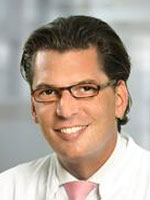The heart is surrounded by a very thin tissue envelope - also called pericardium. If this bag ignites, it is called pericarditis.
For pericarditis many different causes come into question. The most common triggers of pericarditis are viruses that occur as part of a respiratory infection - such as coxsackie viruses, echoes or adenoviruses. However, in some cases, pericarditis may also be the result of another disease, such as lung, kidney, autoimmune and metabolic diseases.
Frequently, in the course of pericarditis, a so-called pericardial effusion develops. In a pericardial effusion, fluid accumulates in the pericardium as a result of pericarditis, which affects the action of the heart above a certain amount.
Symptoms of Pericarditis
Typical symptoms of acute pericarditis are, in addition to increased body temperature, sharp pains below the sternum, which increase when lying down, when inhaled deeply or when coughing and when moving. Frequently, sufferers also suffer from respiratory complaints (e.g., cough and sore throat), indicating the viral cause of pericarditis.
If, in addition to pericarditis, a pericardial effusion develops, further symptoms such as
- protruding (jammed) jugular veins,
- swollen legs (leg edema) and
- a liver enlargement
added. This indicates decreased cardiac output as a result of pericarditis. Those affected feel weakened and less efficient. Chronic pericarditis usually lacks symptoms such as pain and fever.
In extreme cases, so-called heart bag tamponade develops in pericarditis. The large amount of fluid exerts so much pressure on the heart that it can no longer adequately supply the body with blood. The blood pressure drops. The heart bag tamponade can cause a shock.
The diagnosis of pericardial inflammation is made by the doctor on the basis of typical symptoms and different examination methods. These include:
- Electrocardiogram (ECG)
- X-ray
- Blood tests
- Ultrasonic
The treatment of pericarditis is - depending on the cause - with certain drugs. Patients with pericarditis should also take care. If there is a pericardial effusion (pericardial effusion) or a heart bag tamponade, the physician either drains the fluid with a longer drainage or sucks it off with a fine needle (puncture). The pericarditis usually goes well and has a favorable prognosis.
Pericarditis: What Is It?
The term pericarditis describes an inflammatory disease of the pericardium, which may have various causes. The pericardium (Greek: peri-: around ... cardiac: heart) is the outer envelope of the heart. It consists of two thin skins of connective tissue. Between these skins a small amount of fluid is found in healthy people. The pericardium protects the heart from overstretching and external influences. If the pericardium is inflamed together with the heart muscle (myocardium), doctors speak of perimyocarditis.
There is a primary and a secondary form of pericarditis. In primary pericarditis, viruses are usually the immediate causes of disease. In contrast, secondary pericarditis is the result of other diseases, such as lung, kidney, autoimmune or metabolic diseases.
Frequently arises as a result of a pericarditis a Herzbeutelerguss. This accumulates fluid in the pericardium. If a heart pouch becomes very fast, the little elastic pericardium can not expand and an increasing pressure builds up on the heart. In some cases, the heart is restricted in its function.
The most dangerous form of pericardial effusion is the cardiac tamponade. The heart can not work hard enough against the increased pressure - and the bloodstream can no longer adequately supply the organs with blood. A heart bag tamponade is an emergency.
Pericarditis: What Is Behind It?
In pericarditis (pericarditis), the causes are varied. Different types of pericarditis can be distinguished.
The most common triggers of pericarditis are viruses. In addition, but also for example
- Bacteria
- cancers,
- a heart attack,
- kidney disease,
- autoimmune diseases and
- radiate.
Causes of pericarditis.
Viral pericarditis
The most common causes of pericarditis are viruses. The pathogens are often coxsackie viruses. Alternatively come in the case of viral pericarditis as causes of echo or adenoviruses in question. People whose immune systems are weakened, for example in the context of HIV infection or after organ transplantation, can sometimes detect more rare pathogens, such as cytomegalovirus, Epstein-Barr or hepatitis viruses.
Viral pericarditis is often seen after a respiratory infection. But not always the pathogen is detectable. If the exact causes are unknown in pericarditis, doctors speak of idiopathic pericarditis. In every fourth case, the exact cause is unclear in pericarditis.
Bacterial pericarditis
In the case of pericarditis, bacteria are also considered as causes. Bacteria can enter the entire body via the blood from a local inflammation (for example in the tooth area) and also colonize the pericardium. For example, bacterial pericarditis can occur when a tooth has been pulled. The causative agents of pneumonia such as pneumococci or staphylococci as well as the pathogens of tuberculosis (so-called mycobacteria) are possible causes of pericarditis.
If a pericardial effusion occurs in a bacterial pericarditis, the doctor usually derives the excess fluid by puncturing with a fine needle into the pericardium (puncture). The effluent secretion can be examined for germs (so-called pathogen culture). This allows him to determine exactly which bacteria cause pericarditis and select a suitable antibiotic for therapy.
Tuberculous pericarditis
One form of bacterial pericarditis is tuberculous pericarditis. It is rare in Germany and occasionally found in immunocompromised or immigrant people. The causative agent of pericarditis is Mycobacterium tuberculosis. It passes through the bloodstream to the pericardium. In addition to the heart problems, sufferers often suffer from night sweats and weight loss. If pericarditis is caused by tuberculosis, other parts of the body may also be affected by this condition, such as the skin, bowel, or brain.
A serious complication of tuberculous pericarditis is the so-called pericarditis constrictiva. This causes the pericardium to become scarred. The heart can no longer contract properly, the heart function is severely impaired. Another complication of tuberculous pericarditis is calcification. Physicians then speak of a pericarditis calcarea, colloquially also called "armored heart".
Tumor-related pericarditis
Various cancers are also possible causes of pericarditis. For example, in the context of lung or breast cancer as well as leukemias and lymphomas, secondary tumors may settle in the pericardial sac or pericardial effusion may form. Very rarely, cancer develops directly in the pericardium (primary tumor).
Pericarditis epistenocardica
This particular form of pericarditis occurs in some cases within a week of a heart attack. Not all of the pericardium is inflamed, but only those parts of the pericardium that surround the areas of the heart muscle that have been damaged by the heart attack are affected. In severe infarcts, which affect large parts of the heart muscle, the pericarditis occasionally spreads throughout the pericardium. Doctors then speak of the so-called Dressler syndrome.
Pericarditis epistenocardica may also occur after cardiac surgery or as a result of heart injury.
Uremic pericarditis
In case of pericarditis also kidney disease as causes in question. In people with kidney disease who need dialysis, certain substances normally excreted in urine may remain in the body and cause pericarditis. In such cases it is called uremic pericarditis.
Pericarditis in autoimmune diseases
Autoimmune diseases are among the possible causes of pericarditis. In an autoimmune disease, the immune system is not only directed against potential pathogens, but also against the body's own tissue. It can also be the pericardium - it is inflamed and a pericarditis is the result. Among the autoimmune diseases that can be considered as causes of pericarditis include lupus erythematosus, scleroderma, rheumatoid arthritis and granulomatosis with polyangiitis (GPA), formerly known as Wegener's granulomatosis.
Other causes
Rarely, radiation (radioactivity) - for example, as part of a radiation therapy for cancer - or medication cause pericarditis. Thyroid hyperthyroidism (hypothyroidism) or a massive increase in blood cholesterol levels (hypercholesterolemia) can trigger pericarditis.
Pericarditis: Symptoms and Consequences
In pericarditis, the symptoms are not always clear. For example, sufferers suffer from a sudden onset of fever associated with physical weakness. They are also less resilient and feel pain under the sternum or left rib cage.
In acute pericarditis, the pain symptoms are aggravated by movement, flat lying, coughing and deep breathing. In addition, the heart beats faster than normal. Sitting upright or leaning forward sometimes gives relief. Bacterial pericarditis is accompanied by a strong fever.
If pericarditis is chronic, there are usually no noticeable symptoms or only very minor and unspecific symptoms. Affected are less resilient and quickly get out of breath. In addition, in chronic pericarditis, fluid retention (edema) may occur, causing symptoms such as enlarged liver or protruding veins. Often one notices a chronic pericardial disease due to the inconspicuous symptoms but only when complications such as a pericardial effusion occur.
Pericardial
If fluid accumulates as a result of pericarditis between the pericardium and muscle (so-called pericardial effusion, pericardial effusion), the symptoms change. The pain disappears frequently, but there are signs of heart failure. These include jammed neck veins, bilateral fluid retention in the legs (leg edema) or enlargement of the liver, which may accompany ascites.
In heart-healthy persons can be detected in the pericardium about 15 milliliters of a clear, amber, protein-containing liquid. In contrast, blood-rich pericardial effusions occur in tuberculosis or in malignant tumors, purulent effusions in bacterial pericarditis.
Cardiac tamponade
As a complication of an acute pericardial effusion a so-called Herzbeutel tamponade is possible. The pericardial effusion is then so pronounced that the heart is strongly compressed and the ventricles can not fill themselves with enough blood. The heart can then no longer pump enough blood through the circulation; At the same time, the blood builds up in the veins in front of the right ventricle. It is an emergency with hypotension and the symptoms of shock.
Pericarditis: This Is How The Doctor Diagnoses
If you suspect pericarditis (pericarditis), the doctor first asks for the exact symptoms (history) to make the diagnosis. Often the history of the disease includes a previous respiratory infection or diarrhea. This is followed by a physical examination. The doctor listens to the heart with a stethoscope.
At the beginning of pericarditis with missing or small effusion in the pericardium, the doctor perceives a friction noise, the so-called "pericardial rubbing" or "leather cunning". In pericardial effusion, this rubbing often subsides and the heart sounds become quieter.
In order to make the exact diagnosis of pericarditis, the doctor often also uses an electrocardiogram (ECG). He identifies typical changes, some of which are very similar to a heart attack, but normalize again when the pericarditis has healed.
By means of a blood test, inflammation of the body can be detected in pericarditis. If there is an inflammation such as pericarditis in the body, among other things, the number of white blood cells is increased, as well as the rate of erythrocyte sedimentation and the so-called C-reactive protein. For the exclusion of an autoimmune disease, special tests are carried out for antibodies against the body's own tissue structures (so-called autoantibodies). In case of suspected tuberculosis as a trigger of pericarditis, the doctor performs a tuberculosis test as part of the diagnosis.
The ultrasound of the heart (echocardiography) is of great importance, especially with regard to the diagnosis of pericardial effusion. With ultrasound, the doctor can recognize its exact size and location. In some cases, he uses a hollow needle to remove the accumulated fluid from the pericardium (puncture) for later examination in the laboratory. He dotted under local anesthesia (local anesthesia) and ultrasound control below the breastbone. The laboratory staff then examined the dotted liquid laboratory-chemically and assessed possible cells in the effusion under the microscope. In addition, bacterial cultures are created from the liquid obtained. If the liquid contains bacteria, the respective pathogen can be determined.
The results of an X-ray examination of the chest are conspicuous only in severe or chronic courses of pericarditis or pronounced pericarditis. Sometimes the doctor notes a tent-like enlargement of the heart in the form of a "box pouch" (Frankenweinflasche) or calcifications.
Medication Therapy
In case of pericarditis (pericarditis), it is important to support the therapy to protect oneself physically. Certain medications help to relieve the symptoms. In some cases, surgery is useful.
In pericarditis (pericarditis), the drug therapy depends on the exact causes of inflammation. Commonly occurring viral pericarditis is the treatment of symptoms with analgesics and anti-inflammatory drugs. In general, non-steroidal anti-inflammatory drugs and, if these do not work sufficiently, glucocorticoids are used. Dehydrating medications (diuretics) and ACE inhibitors improve the symptoms of heart failure due to pericarditis.
In bacterial pericarditis, the doctor prescribes antibiotics for therapy. If tuberculosis has triggered pericarditis, combined therapy with multiple drugs that work against the causative bacteria is required. Patients receiving acetylsalicylic acid are occasionally exposed to epistemic pericarditis after a heart attack.
In other, secondary forms of pericarditis, the treatment of the underlying disease is in the foreground. The autoimmune-triggered pericarditis is treated by immunoregulatory drugs such as glucocorticoids. Such drugs reduce the body's defenses and thus reduce the immune response to your own tissue.
However, if the inflammation is triggered by a kidney failure, a dialysis for blood purification is necessary. Tumor-related pericarditis requires surgery of the tumor, chemotherapy and / or radiation treatment.
Pericardial Puncture and Pericardial Fenestration
With pronounced pericardial effusion or heart bag tamponade as a result of pericarditis, drug therapy alone is not enough. Since this is usually an emergency situation, the goal of the treatment is first to relieve the heart. The doctor performs a so-called pericardial puncture: He pricks with a fine needle into the pericardium and removes the excess fluid. In the case of rapidly passing effusions (for example, in the context of bacterial endocarditis), it drains - ie drains the fluid. A catheter remains in the pericardium. This allows the doctor to derive the replication effusion at regular intervals and thus relieve the heart. Patients with pericardial effusion receive intensive medical care.
Pericardium fenestration
In the case of severe history of pericarditis with repeated pericardial tamponades, the physician can perform a so-called pericardial fenestration. This means that the doctor creates a passage in the pericardium during an operation, whereby the effusion is discharged directly into the so-called pleural cavity - where the liquid is finally taken up (resorbed) by the cells. The pleural cavity is the space between the lung surface and the inner wall of the rib cage. The pleural cavity is - similar to the pericardium - lined by two thin skins of connective tissue (pleura and lung pelt) and naturally contains a small amount of fluid.
In the so-called pericarditis constrictiva ("armor heart"), a form of chronic pericarditis, the pericardium increasingly solidifies (connective tissue Verschwielung the pericardium). As this makes the heartbeat increasingly difficult, it may be necessary to remove the pericardium.
Course and Prevention
Course
Pericarditis (pericarditis) usually shows a good course. The most common forms of pericarditis, the idiopathic (cause unknown) or viral pericarditis, usually heal after one to three weeks. If complications occur in pericarditis, this affects the course of the disease but unfavorable.
Complications
The pericarditis (pericarditis) can progress in the course of the other layers of the heart and lead to complications. Then it comes in addition to inflammation of the heart muscle (perimyocarditis) and more rarely the inner heart layer (endocarditis) or all the heart layers (pancarditis).
Two major complications of pericarditis are pericarditis constrictiva and cardiac tamponade, a severe form of pericardial effusion. In pericarditis constrictiva, the so-called "armored heart", the pericardium hardens like a capsule, calcified and laced up scarred. As a result, the heart can not optimally fill with blood and its pumping function is severely impaired. The affected people accumulate blood in the neck veins and they are short of breath. Swelling (edema) of the legs is also noticeable, the liver swells and eventually fluid collects in the abdominal cavity (ascites). Those affected are usually very weak.
The x-ray often shows a normal sized heart. Nevertheless, if there is a heart failure (heart failure), the doctor usually concludes a pericarditis constrictiva. This form of pericarditis can develop over several years, with the initial stages usually being symptom-free. In Germany radiotherapy rarely occurs in persons with tumors, after heart surgery or in the context of autoimmune diseases to a pericarditis constrictiva. The symptoms are similar to a pericardial tamponade. Due to the decrease in tuberculosis - the main cause of pericarditis constrictiva - this complication is rare in Germany.
The heart bag tamponade is one of the complications of pericarditis - it is an emergency situation. Since the pericardium is hardly stretchable, liquid that accumulates in it during pericarditis (pericardial effusion), pushes on the inner heart. With effusions from about 150 milliliters, complaints usually occur. Especially with chronic progressions, however, significantly larger amounts of fluid can occur. From a volume of 300 to 400 milliliters, there is the possibility that a so-called cardiogenic shock occurs.
The atria put little pressure on the external pressure through the fluid; therefore they are particularly compressed. As a result, the heart no longer fills up sufficiently with blood and thus throws only little blood volume. Patients with cardiac tamponade fall in an acute course of the blood pressure, the heart rate is accelerated. They show signs of right heart failure and get bad breath. The cardiac tamponade usually treats the doctor by draining fluid from the pericardium (puncture and drainage). However, as a result of drainage in pericarditis, five percent of the cases involve severe complications such as bleeding or malposition.
Forecast
In pericarditis (pericarditis), the prognosis is usually good. Only rarely do you develop larger amounts of fluid and thus a pericardial tamponade in a pericardial effusion. Likewise, pericarditis constrictiva is rare, which has a rather unfavorable prognosis. However, the so-called idiopathic form of pericarditis, which develops without obvious causes, sometimes occurs again and can be chronic. Sometimes, over a period of years, chest pains and fever appear again and again. Frequently, these recurring symptoms lead to a wrong diagnosis.
Bacterial pericarditis may in some cases have an unfavorable prognosis - the disease can be life-threatening, if the drugs administered (antibiotics) do not work or not enough. In addition to tuberculous and tumor-induced pericarditis, bacterial pericarditis has the highest tendency to develop a pericardial tamponade as a complication.
Prevent
Pericarditis (pericarditis) can not be reliably prevented - there are no general protective measures against pericarditis. However, it is important that possible underlying diseases (such as infections, metabolic and cancer diseases) be detected and treated early. Recurrent idiopathic pericarditis can prevent the drug colchicine.























 Loading ...
Loading ...


